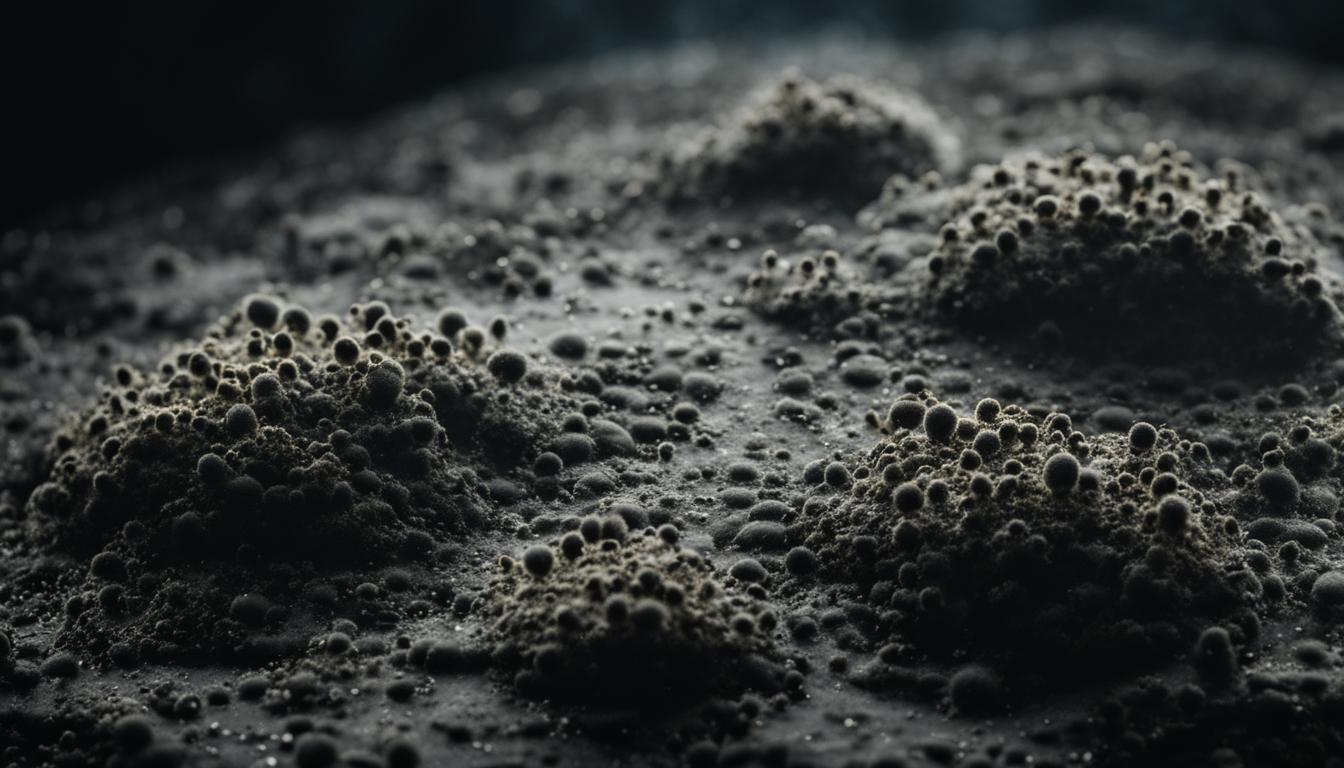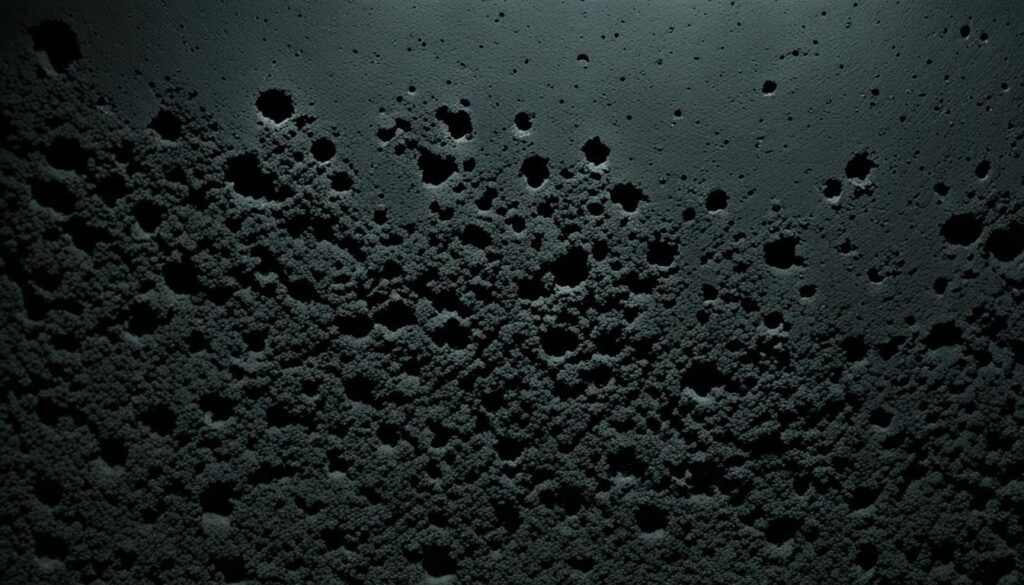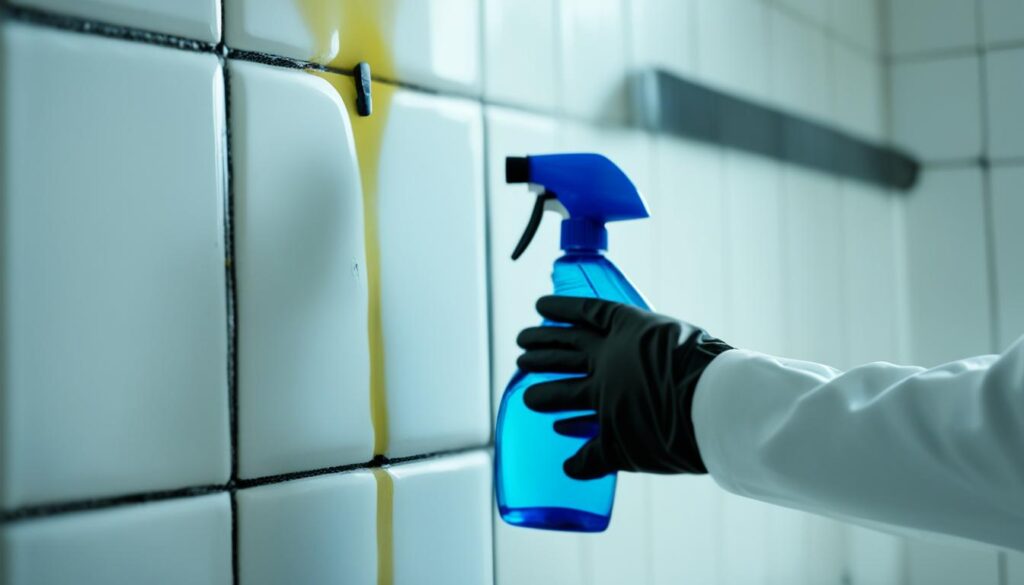
Black Mold Dangers & Removal Guide | Vital Tips
Black mold can be a serious threat to both your health and the structural integrity of your home. Understanding the dangers associated with black mold and learning effective removal strategies is crucial for maintaining a safe living environment. In this article, we will explore the risks posed by black mold and provide you with vital tips to ensure its safe removal.
Key Takeaways:
- Black mold poses significant health risks and should be taken seriously.
- Common symptoms of black mold exposure include respiratory issues, allergic reactions, and skin irritation.
- Removal of black mold should be done with caution to prevent further contamination.
- Proper ventilation, moisture control, and regular inspections can help prevent black mold growth.
- Consulting a professional for black mold removal is often recommended for larger or persistent infestations.
Understanding Black Mold: Health Risks and Symptoms
Black mold, also known as Stachybotrys chartarum, is a type of mold that can pose significant health risks when present in homes or buildings. This section will explore the potential dangers associated with black mold and discuss the common symptoms that indicate exposure.
Exposure to black mold can lead to various health problems, particularly for individuals with sensitivities or pre-existing respiratory conditions. Inhalation or contact with black mold spores can trigger allergic reactions and respiratory issues, including coughing, wheezing, congestion, and throat irritation.
The severity of symptoms can vary depending on the individual’s sensitivity and the extent of exposure. Some individuals may experience more severe reactions, such as persistent coughing, difficulty breathing, and even asthma attacks. Prolonged exposure to black mold may also lead to chronic respiratory conditions and other health complications.
To effectively address black mold issues and protect your well-being, it’s crucial to be aware of the common symptoms that may indicate its presence in your environment. If you or your family members experience any of the following symptoms, it’s important to consult with a healthcare professional and consider investigating for black mold:
- Coughing and sneezing
- Watery and itchy eyes
- Runny or congested nose
- Throat irritation
- Headaches
- Fatigue
- Shortness of breath
- Skin rashes or irritation
It’s important to note that these symptoms may not be exclusive to black mold exposure and can be indicative of other respiratory issues or allergies. However, if you notice these symptoms worsening or persisting in certain environments or specific areas of your home, it could be a potential indication of black mold presence.
To assist in diagnosing black mold exposure, healthcare professionals may perform clinical evaluations, conduct skin tests, or recommend air and mold testing in your living space. Proper identification and remediation of black mold are essential for your health and well-being.
“Black mold exposure can pose significant health risks, particularly for individuals with respiratory sensitivities. Recognizing the symptoms and taking appropriate measures to address the issue is crucial for maintaining a healthy living environment.”
| Health Risks | Symptoms |
|---|---|
| Allergic reactions | Coughing |
| Respiratory issues | Sneezing |
| Throat irritation | Watery and itchy eyes |
| Asthma attacks | Runny or congested nose |
| Chronic respiratory conditions | Headaches |
| Fatigue | |
| Shortness of breath | |
| Skin rashes or irritation |
Being aware of the health risks and symptoms associated with black mold exposure empowers individuals to take necessary precautionary measures and seek appropriate remediation when needed. The next section will provide effective strategies to safely remove black mold from your home, ensuring a healthier living environment.

Effective Strategies for Black Mold Removal
If you’ve discovered black mold in your home, taking immediate action is crucial to protect your health and prevent further damage. Here, we provide a comprehensive guide on removing black mold and offer effective strategies, tools, and techniques to ensure a safe and thorough removal process.
1. Safety First: Protective Gear and Ventilation
Before starting the black mold removal process, it’s essential to prioritize your safety. Always wear protective gear, including gloves, goggles, and a respirator, to prevent direct exposure to mold spores. Additionally, ensure proper ventilation in the affected area by opening windows and using fans to improve air circulation.
2. Determine the Extent of Infestation
Begin by evaluating the extent of the black mold infestation. Inspect the affected area thoroughly, including hidden spaces such as behind walls and under carpets. Identify any sources of moisture or water leaks that may contribute to mold growth. This assessment will guide your removal plan and help prevent future mold outbreaks.
3. Containment and Isolation
To prevent the spread of mold spores, it’s crucial to contain and isolate the affected area. Use plastic sheets or tarps to seal off the workspace and cover any ventilation shafts or openings. This containment measure helps minimize the risk of cross-contamination and protects other areas of your home from mold exposure.
4. Remove and Dispose of Mold-Infested Materials
For effective black mold removal, it’s essential to discard mold-infested materials properly. Wear gloves and use heavy-duty garbage bags to seal and dispose of porous items, such as carpets, wallpaper, or drywall, that cannot be salvaged. Double-bag the materials to prevent mold spores from escaping and contaminating other areas.
5. Clean and Disinfect Surfaces
Thoroughly clean and disinfect all non-porous surfaces in the affected area. Use a solution of water and detergent or a specialized mold cleaner to remove visible mold growth. After cleaning, apply a disinfectant to kill any remaining mold spores and inhibit future growth. Follow the manufacturer’s instructions and safety guidelines when using cleaning and disinfecting products.
6. Dry the Area Completely
After removing the mold and cleaning the surfaces, it’s crucial to dry the area thoroughly. Mold thrives in damp conditions, so use dehumidifiers and fans to reduce humidity levels and accelerate drying. Ensure that the area is completely dry before proceeding with any repairs or renovations.
7. Address Underlying Moisture Issues
To prevent black mold from returning, you must address any underlying moisture issues in your home. Fix water leaks promptly, repair damaged pipes, and implement proper ventilation in areas prone to excessive humidity. By eliminating the source of moisture, you can effectively prevent mold growth and maintain a mold-free environment.

By following these effective strategies for black mold removal, you can safeguard your health and restore a mold-free living environment. Remember to take necessary precautions, thoroughly clean and disinfect affected areas, and address any underlying moisture issues to prevent future mold outbreaks.
Conclusion
In conclusion, addressing black mold promptly is crucial for maintaining a healthy living environment. Throughout this article, we have emphasized the dangers associated with black mold and provided vital tips for its safe removal.
By understanding the health risks and symptoms associated with black mold, you can take the necessary precautions to protect yourself and your loved ones. Regular inspections, proper ventilation, and humidity control are essential in preventing the growth of black mold in your home.
When it comes to black mold removal, following effective strategies is key. Whether it’s using bleach solutions, hydrogen peroxide, or hiring professional services, it is important to eradicate black mold thoroughly and prevent its reappearance.
Remember, mold is not something to be taken lightly. It can lead to severe health issues and damage to your property if left unaddressed. By implementing the tips and techniques discussed in this article, you can ensure a mold-free environment and safeguard your well-being for years to come.




